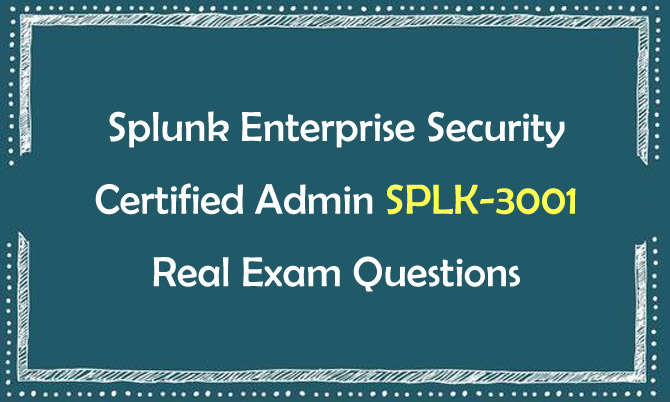Are you planning to take SPLK-3001 Splunk Enterprise Security Certified Admin exam? We have cracked the latest Splunk Enterprise Security SPLK-3001 real exam questions, which can save your time in preparing SPLK-3001 exam. To prepare SPLK-3001 exam well, the official Splunk Enterprise Security Certified Admin SPLK-3001 exam duration, topics and real exam questions are important parts in your study.

Splunk SPLK-3001 Exam Duration
This app-specific certification Splunk exam is a 57-minute, 66-question assessment. Candidates can expect an additional 3 minutes to review the exam agreement, for a total seat time of 60 minutes. The registration fee of Splunk Enterprise Security Certified Admin SPLK-3001 exam is $125. Splunk certification exams are available at Pearson VUE test center or via online Proctor. Change or cancel an existing appointment less than 48 hours in advance.
SPLK-3001 Splunk Enterprise Security Exam Topics
Splunk Enterprise Security Certified Admin SPLK-3001 exam is not much difficult for you to prepare. The following contents are covered in Splunk Enterprise Security SPLK-3001 exam topics.
1.0 ES Introduction 5%
2.0 Monitoring and Investigation 10%
3.0 Security Intelligence 5%
4.0 Forensics, Glass Tables, and Navigation Control 10%
5.0 ES Deployment 10%
6.0 Installation and Configuration 15%
7.0 Validating ES Data 10%
8.0 Custom Add-ons 5%
9.0 Tuning Correlation Searches 10%
10.0 Creating Correlation Searches 10%
11.0 Lookups and Identity Management 5%
12.0 Threat Intelligence Framework 5%
Learn Splunk SPLK-3001 Real Exam Questions
With the new cracked Splunk SPLK-3001 real exam questions, you can test all the above exam topics. Share some Splunk Enterprise Security Certified Admin SPLK-3001 real exam questions below.
1.Which setting is used in indexes.confto specify alternate locations for accelerated storage?
A. thawedPath
B. tstatsHomePath
C. summaryHomePath
D. warmToColdScript
Answer: B
2.Which of the following is a way to test for a property normalized data model?
A. Use Audit -> Normalization Audit and check the Errors panel.
B. Run a | datamodelsearch, compare results to the CIM documentation for the datamodel.
C. Run a | loadjobsearch, look at tag values and compare them to known tags based on the encoding.
D. Run a | datamodelsearch and compare the results to the list of data models in the ES normalization guide.
Answer: B
3.Which argument to the | tstats command restricts the search to summarized data only?
A. summaries=t
B. summaries=all
C. summariesonly=t
D. summariesonly=all
Answer: C
4.When investigating, what is the best way to store a newly-found IOC?
A. Paste it into Notepad.
B. Click the “Add IOC” button.
C. Click the “Add Artifact” button.
D. Add it in a text note to the investigation.
Answer: B
5.How is it possible to navigate to the list of currently-enabled ES correlation searches?
A. Configure -> Correlation Searches -> Select Status “Enabled”
B. Settings -> Searches, Reports, and Alerts -> Filter by Name of “Correlation”
C. Configure -> Content Management -> Select Type “Correlation” and Status “Enabled”
D. Settings -> Searches, Reports, and Alerts -> Select App of “SplunkEnterpriseSecuritySuite” and filter by “-Rule”
Answer: A
